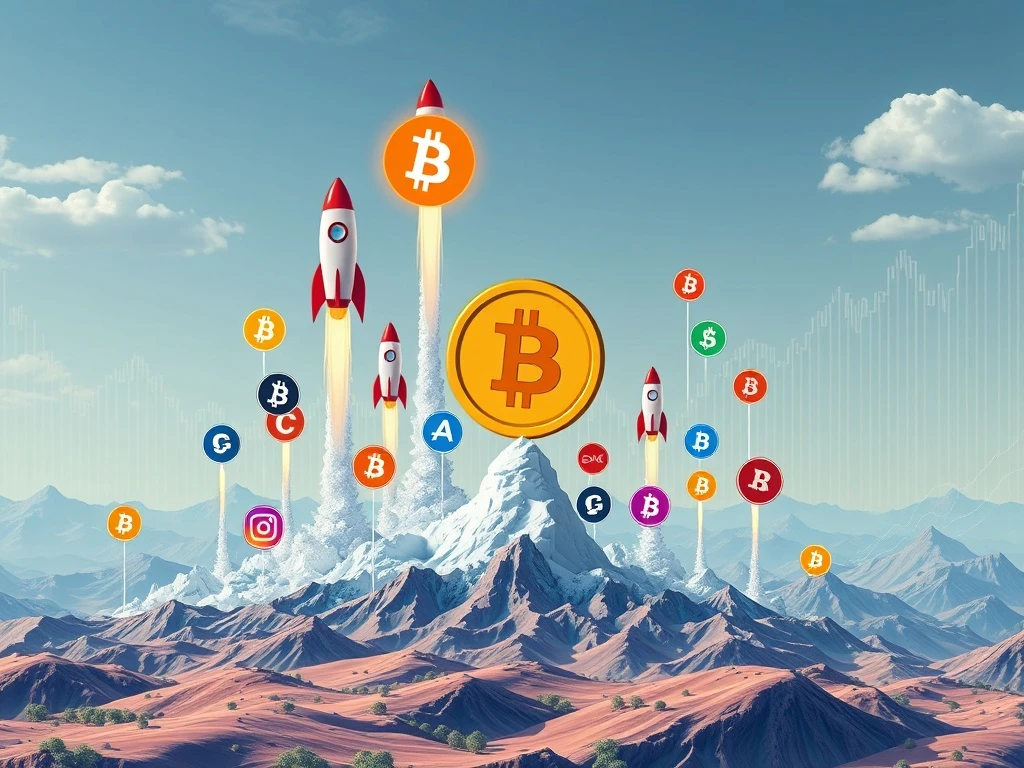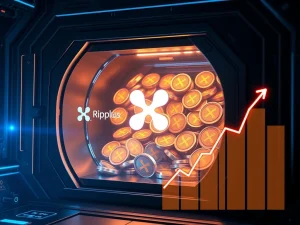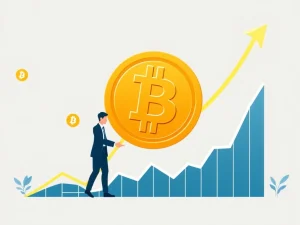Altcoin Season: Unveiling Explosive Crypto Market Rallies

The allure of massive gains often defines the cryptocurrency landscape. Investors frequently seek opportunities beyond Bitcoin. This search often leads to a period known as **altcoin season**. It promises significant returns. Understanding what truly drives altcoin season is crucial for any crypto enthusiast. This guide explores the core mechanisms behind these powerful market shifts.
What is Altcoin Season? Defining the Phenomenon
Altcoin season, or “altseason,” represents a distinct market phase. During this time, cryptocurrencies other than Bitcoin experience rapid price increases. These gains significantly outpace Bitcoin’s performance. Investors shift capital from **Bitcoin (BTC)** into various alternative assets. These include Ether (ETH), Solana (SOL), Cardano (ADA), and even smaller tokens like Dogecoin (DOGE) or Pudgy Penguins (PENGU).
A widely accepted benchmark for altseason is the Altcoin Season Index. According to Blockchain Center, altseason begins when at least 75% of the top 100 altcoins outperform Bitcoin over a 90-day period. Historically, these periods have delivered substantial returns. For example, in the 2021 cycle, large-cap altcoins saw approximately 174% gains. Bitcoin, however, advanced only about 2% during the same span. Therefore, identifying the consistent drivers of **altcoin season** is vital for strategic investment.
Bitcoin’s Price Cycle: The Catalyst for Altcoin Rallies
Bitcoin serves as the crypto market’s primary indicator. Its price movements often pave the way for altcoin season. Typically, an altseason follows a strong Bitcoin bull run. When Bitcoin surges, perhaps crossing significant milestones like $100,000, new capital flows into the market. Once Bitcoin’s price stabilizes or consolidates, traders often rotate their profits. They move this capital into altcoins, seeking higher returns from more volatile assets. This pattern reflects basic market psychology. Bitcoin’s initial rally boosts overall market confidence. As Bitcoin’s growth slows, investors actively search for the next big opportunity. Altcoins, with their potential for outsized gains, become a preferred choice for **altcoin investment**.
For instance, after Bitcoin’s 124% gain in 2024, twenty of the top 50 altcoins surpassed its performance. This signaled the early stages of an altseason. A critical metric to monitor is **Bitcoin dominance (BTC.D)**. This measures Bitcoin’s share of the total crypto market capitalization. When BTC.D drops below 50%-60%, it frequently indicates capital moving into altcoins. In August 2025, Bitcoin dominance fell to 59% from 65%. This decline strongly suggested an impending altseason. A sustained **Bitcoin dominance drop** often precedes widespread altcoin gains.
Market Sentiment and FOMO: Powering Crypto Market Trends
Altcoin season thrives on human emotion, particularly the fear of missing out (FOMO). As altcoins like Ether or memecoins such as Pepe (PEPE) begin posting double- or triple-digit gains, social media platforms ignite. Platforms like X, Reddit, and Telegram buzz with excitement. This buzz creates a powerful feedback loop. Rising prices attract more investors, which drives prices even higher. In 2024, memecoins like Dogwifhat (WIF) surged over 1,100%, largely fueled by community-driven excitement.
Social media trends act as a leading indicator of altcoin season. Increased discussions on platforms like X often precede price rallies. Retail investors jump in to capitalize on the momentum. For example, in 2025, Google Trends data for “altcoins” reached an all-time high in August. This surpassed the May 2021 altseason peak. Search interest entered “price discovery” during Bitcoin’s consolidation above $110,000. This surge reflects exploding retail FOMO, especially for ETH, SOL, and memecoins like DOGE. Institutional exchange-traded fund (ETF) inflows, such as $4 billion into ETH, further rotate capital into altcoins, shaping current **crypto market trends**.
Macroeconomic Factors: Fueling Altcoin Investment
The broader economic landscape significantly influences altcoin season. Macroeconomic conditions like interest rates, inflation, and global liquidity profoundly impact crypto markets. When central banks, such as the US Federal Reserve, cut interest rates or increase liquidity through quantitative easing, riskier assets tend to thrive. Lower interest rates push investors away from traditional safe havens like bonds. They instead move into high-risk, high-reward assets, including altcoins. For instance, analysts anticipate that Fed rate cuts in 2025 could inject substantial liquidity into markets. This would fuel **altcoin investment** momentum.
Conversely, tighter monetary policies can suppress altcoin growth. They achieve this by reducing market liquidity. In 2020-2021, aggressive money printing and low interest rates created ideal conditions for altcoins. The altcoin market cap hit record highs. Geopolitical events and regulatory developments also play a role. Pro-crypto policies in major markets, like the US or EU, boost investor confidence. This drives capital into altcoins. For example, the 2024 approval of Ether spot ETFs saw inflows nearing $4 billion by August 2025. This demonstrates how regulatory clarity sparks altcoin rallies and encourages further **altcoin investment**.
Innovation & Narratives: Shaping Altcoin Season Themes
Altcoin season is not merely about hype. It is often driven by genuine technological advancements and emerging narratives. Each altseason typically features a defining theme. In 2017, the Initial Coin Offering (ICO) boom dominated. The 2021 cycle saw Decentralized Finance (DeFi) and Non-Fungible Tokens (NFTs) take center stage. In 2025, analysts highlight several key drivers. These include AI-integrated blockchain projects, tokenization of real-world assets (RWAs), and Layer-2 solutions.
Platforms like Ethereum, Solana, and Avalanche are gaining traction. They offer scalability and support for tokenized securities, from stocks to real estate. These innovations attract **institutional crypto** capital. This capital often flows into altcoins before retail investors join in. Ethereum, in particular, holds a pivotal role. As the backbone of DeFi, NFTs, and Layer-2 solutions, Ether’s price surges frequently signal the beginning of broader **altcoin season** rallies. These technological shifts create new opportunities and narratives for investors.
Institutional Capital and Retail Amplification: Driving Altcoin Growth
The crypto market has matured significantly. Institutional adoption now acts as a major driver of altcoin season. Unlike past retail-led booms, 2025 sees institutional capital leading the charge. Bitcoin dominance dropped below 59%. This echoes pre-altseason trends from 2017 and 2021. Ether ETFs alone amassed nearly $4 billion in inflows by August 2025. Solana and XRP (XRP) ETF reviews signal broader institutional interest. The US Securities and Exchange Commission’s (SEC) streamlined ETF listing rules in September boosted over 90 applications. XRP ETF approval odds stand at 95%, potentially unlocking $4.3 billion-$8.4 billion in new capital.
Solana exchange-traded products have seen $1.16 billion year-to-date inflows. CME’s SOL/XRP futures options launch in October 2025 will attract hedge funds. Retail investors amplify this momentum through FOMO. Memecoins like DOGE (up 10% to $0.28) and presale tokens surge dramatically. CryptoQuant data shows altcoin trading volume on Binance Futures hit $100.7 billion daily in July 2025. This marks the highest since February, driven by altcoin-to-stablecoin trades, not just BTC rotation. DeFi total value locked (TVL) reached over $140 billion. The Altcoin Season Index hit 76, with 75% of altcoins outperforming BTC. This $4-trillion market cap growth reflects fresh capital. October’s ETF decisions could trigger over $5 billion of inflows. This blends institutional stability with retail hype, supporting sustained **altcoin rallies** in Q4. The growing presence of **institutional crypto** validates the market.
Spotting Altcoin Season: Key Metrics to Monitor
Investors can identify an impending altcoin season by monitoring several key indicators. In the past, analysts suggested that altcoin season was signaled when Bitcoin dominance fell below 55%. An Altcoin Season Index above 75, coupled with rising altcoin-to-stablecoin volumes and strong technical indicators, also pointed to altseason. Today, these metrics remain vital for informed decision-making:
- Altcoin Season Index: A score above 75 confirms altseason. Recent readings in September 2025 hovered around 78, indicating early momentum.
- Bitcoin Dominance (BTC.D): A drop below 55%-60% often signals capital flowing into altcoins. A significant **Bitcoin dominance drop** suggests a market shift.
- Trading Volume: Spikes in altcoin trading activity reflect growing investor interest and liquidity.
- Market Cap Growth: The altcoin market cap reached $1.63 trillion in September 2025, nearing its all-time high. This shows significant expansion.
- Technical Indicators: Tools such as the Relative Strength Index (RSI) and the Moving Average Convergence/Divergence (MACD) help identify optimal entry and exit points for **altcoin investment**.
Risks and Strategies for Smart Altcoin Investment
While altcoin season offers immense opportunities, it carries inherent risks. Altcoins are highly volatile. They often lose 50%-90% of their value after their peak. Speculative hype, outright scams, and regulatory uncertainty can quickly derail gains. To maximize returns while managing these risks, consider these proven strategies:
- Diversify: Spread investments across large-cap (e.g., Ether), mid-cap (e.g., Aave), and small-cap coins. This creates a balanced risk profile.
- Use Technical Analysis: Monitor RSI and MACD for optimal entry and exit points. This helps time your trades effectively.
- Set Stop-Losses: Protect against sudden crashes with predefined exit strategies. This limits potential losses.
- Stay Informed: Follow X, Reddit, and reputable crypto news sources for emerging trends and market sentiment.
- Secure Profits: Use reliable wallets with two-factor authentication (2FA) to safeguard your gains.
However, caution remains paramount. The crypto market is inherently unpredictable. Altseason is often only truly clear in hindsight. By understanding the key drivers—such as Bitcoin’s cycle, market sentiment, macroeconomic conditions, and technological trends—investors can better position themselves. They can ride the wave of **altcoin rallies** while effectively managing associated risks. Smart **altcoin investment** requires both insight and discipline.










